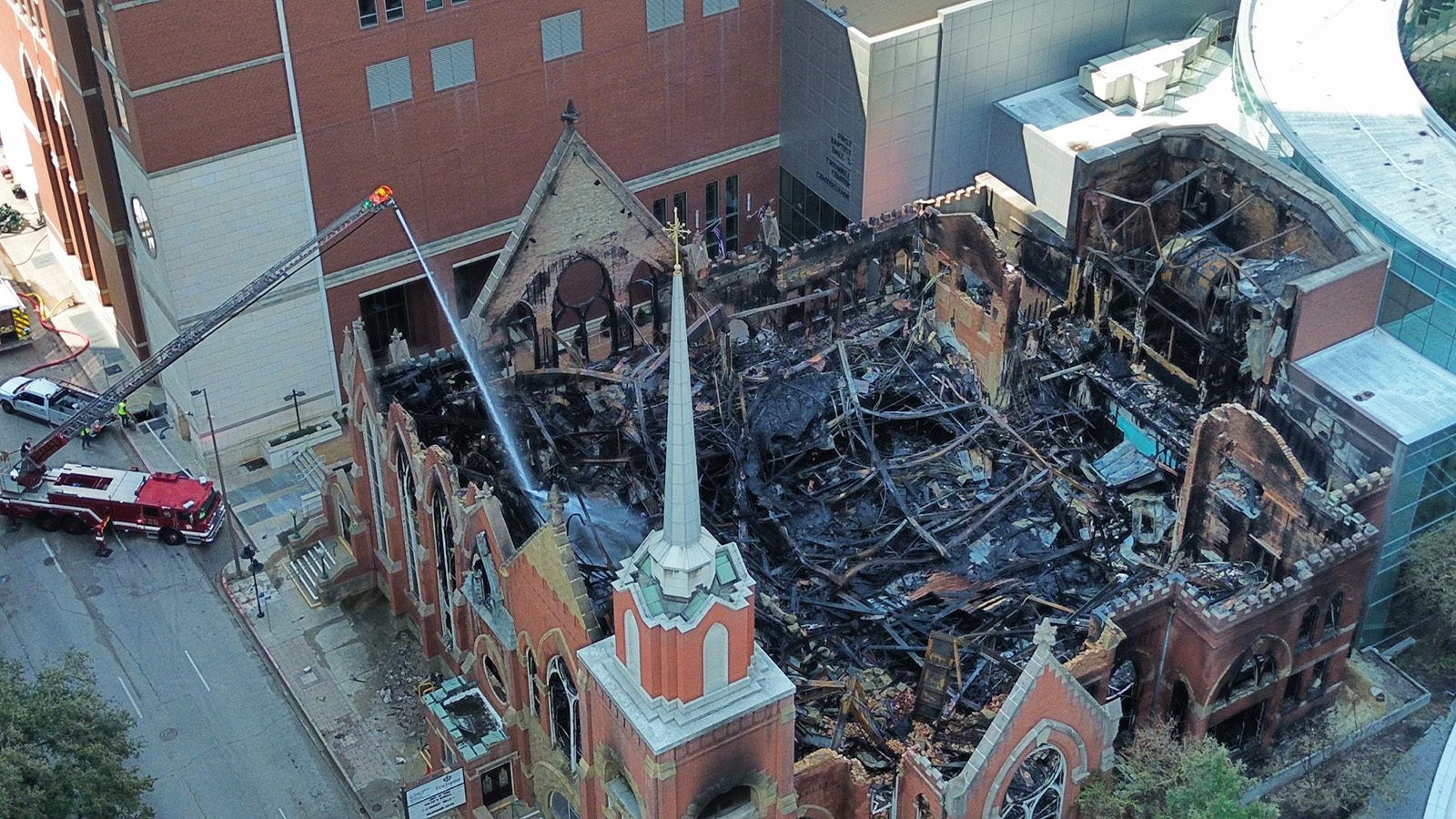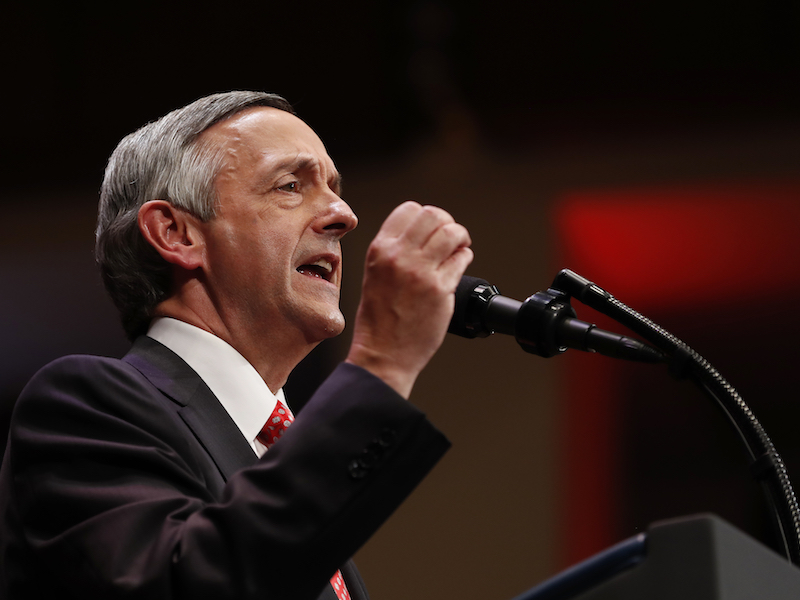
[ad_1]
FORT WORTH, Texas (RNS) — After the fire that all but destroyed the historic chapel at First Baptist Dallas on Friday (July 19), senior pastor Robert Jeffress promised congregants that the church will rebuild.
“It’s not the building, it’s what that building represents: It represented the bedrock foundation of God’s Word that never changes,” said the megachurch’s leader since 2007 at the Kay Bailey Hutchison Convention Center at First Baptist’s Sunday service.
While the fire did not damage the church’s primary modern worship space, the six blocks of the campus remained blocked Sunday morning for first responders. Executive Pastor Ben Lovvorn said Tuesday that the church campus will remain closed all week but teams are currently “making great, great progress” to reopen the worship space for services on Sunday. The cause of the blaze has not yet been determined.
The damage to the historic sanctuary is extensive with a collapsed roof. The church still awaits repair estimates and expects insurance to cover the expense. Jeffress pledged to “rebuild and re-create that sanctuary as a standing symbol of truth.”
The commitment to rebuilding is no surprise. The 134-year-old two-story red brick Victorian chapel symbolizes the church’s relationship with the city and has become a point of pride for congregants and preservationists alike. Jeffress’ commitment echoes previous leaders who have helped the church grow into one of the largest Southern Baptist churches in the country, now boasting 16,000 members.
The church was founded in 1868. Its 11 members initially worshipped in a nearby Mason Hall. According to the state historic marker at the site, an aggressive fundraising campaign “financed by weaving rugs, making hominy, preserves, and cheese to sell at fairs” eventually led them to build a one-room frame structure.
The current chapel opened in 1890 on the same site. It was designed by Albert Ullrich, a Presbyterian architect who lived in Dallas before moving to New York. It was a notable presence in the growing downtown, along with the red brick county courthouse, which opened in 1892. Eventually the chapel expanded to seat up to 3,000 people.

Pastor Robert Jeffress of the First Baptist Dallas Church in 2017. (AP Photo/Carolyn Kaster)
Dallas, like many cities in the mid-20th century, preferred tearing down older buildings to preserving them. But longtime pastors preceding Jeffress, G.W. Truett and W.A. Criswell, who each served for 47 years, knew they could expand their downtown footprint while preserving the chapel. At the church’s 75th anniversary celebration in 1943, a year before Truett died, a pamphlet declared its allegiance to downtown:
“There is a great work for our church yet to do. Every city needs a strong downtown church to keep the community church-minded. With the future growth of Dallas clearly assured, our church must meet the great challenge and carry on a large ministry to the people, in the name of the Lord Jesus Christ, our divine head.”
Criswell, one of the architects of the Conservative Resurgence within the Southern Baptist Convention, oversaw the church’s massive downtown expansion, now spanning six blocks.
“We are downtown because we choose to be downtown,” said Criswell, a two-time president of the SBC.
Under Criswell’s leadership, the church became one of the largest landowners downtown. While expanding its reach, Criswell orchestrated an ambitious and controversial plan for the denomination as leader of the Conservative Resurgence. He also led an expansion of ministries throughout the region.
A second, glass sanctuary and corporate-style campus opened in 2013. Its $135 million fundraising drive under Jeffress was the largest campaign in Protestant history.
Jeffress is, like his predecessors, an ambitious, controversial pastor and political leader. He is a spiritual adviser to former President Donald Trump and appears regularly on conservative talk shows. Throughout the years Presidents Woodrow Wilson, Gerald Ford, George H.W. Bush and Trump have visited the church. Gov. Greg Abbott spoke at the church in 2018 during a 150th anniversary celebration.

Firefighters battle a blaze at the historic sanctuary of First Baptist Church of Dallas on July 19, 2024. (Photo courtesy of First Baptist Dallas)
When talking about the chapel and the church’s decision to stay downtown, Jeffress told The Dallas Morning News in 2013 that staying downtown was part of its identity and ministry. This commitment is why, unlike other megachurches, it did not move to the suburbs.
“I believe the downtown area will be a source of ministry,” Jeffress said. “We want to attract the growing number of people living in both Uptown and downtown. But we will continue to draw people from the entire region.”
At Sunday’s service, Jeffress said architects told him any new modern facility “would be an architectural monstrosity.”
Mark Lamster, the News’ architecture critic, agreed. He described the Beck Group’s expansion in 2013 as “more befitting of a commercial office building than a center for divine transcendence.”
But on Sunday, Jeffress defended it. “It was a theological necessity because we were painting a picture to people throughout the community and world that, yes, methods change for sharing the gospel, media changes, but the message never changes; the message remains the same,” he said. “And having that old Victorian style building right next to a building filled with glass and all the modern technologies is a reminder, was a constant reminder, that the truth of God’s Word never, never changes.”
[ad_2]